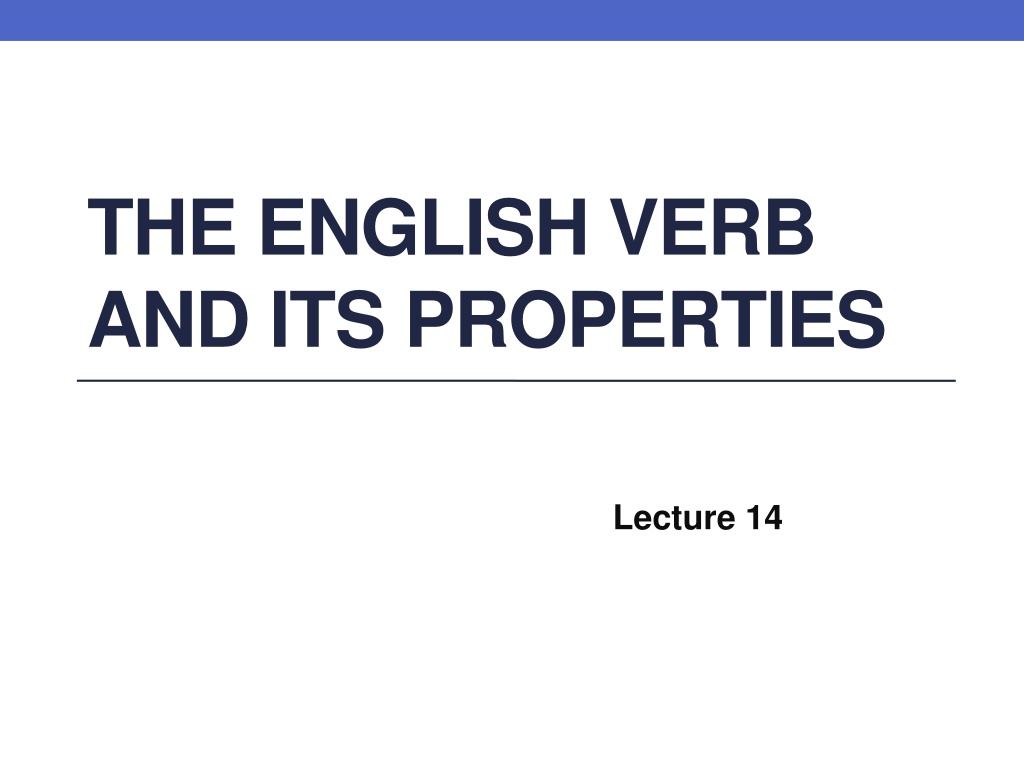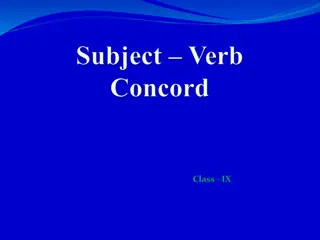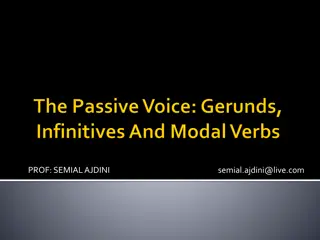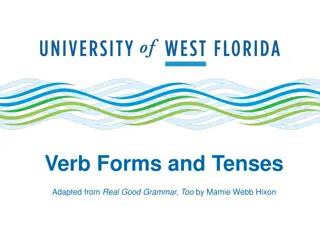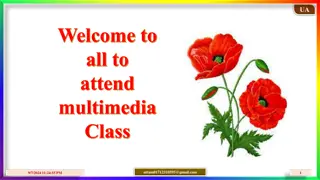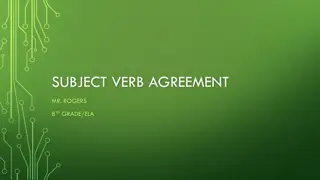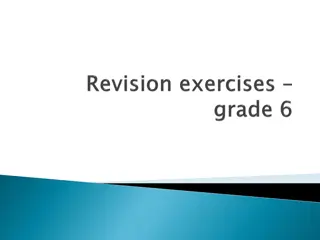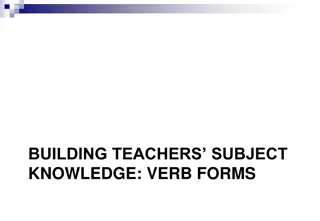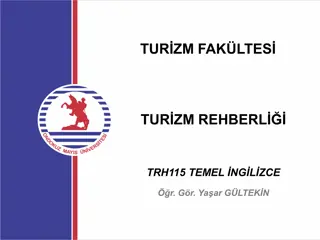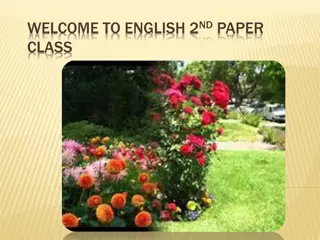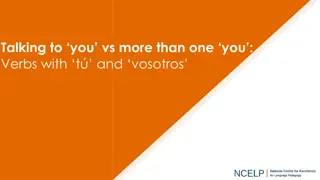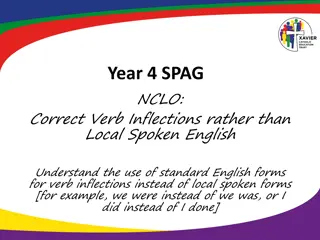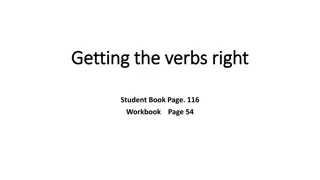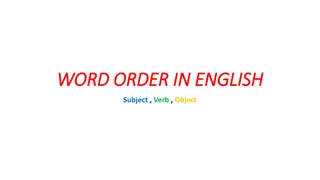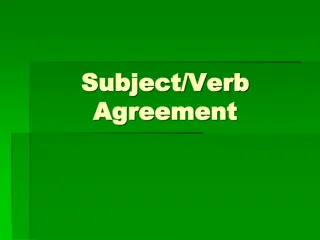Understanding Properties of the English Verb
The English verb plays a central role in expressing predicative functions in sentences, connecting the situation with reality. It encompasses finite and non-finite forms, such as simple, expanded, stress-replacive, and phrasal verbs. Verbs are categorized as notional or functional, actional or statal, transitive or intransitive, based on their usage and meaning. Finitude is a key category for analyzing verbal forms. Explore the complexities and nuances of the English verb in this insightful lecture.
Download Presentation

Please find below an Image/Link to download the presentation.
The content on the website is provided AS IS for your information and personal use only. It may not be sold, licensed, or shared on other websites without obtaining consent from the author. Download presentation by click this link. If you encounter any issues during the download, it is possible that the publisher has removed the file from their server.
E N D
Presentation Transcript
THE ENGLISH VERB AND ITS PROPERTIES Lecture 14
14.1. The Verb. General notion. 14.2. Non-Finite Forms of the Verb
The Verb. General notion The verb is the most complex part of speech and has the central role mostly due to the expression of the predicative functions of the sentence. The predicative functions imply establishing the connection between the situation named in the utterance and the reality. The verb is inherent not only in the complex structure of its grammatical categories but also in its various subclass divisions: the finite set and the non-finite set. As for the outward structure, the verb may be: simple; expanded; sound-replacive; stress-replacive composite; phrasal.
The Verb. General notion Simple verb stems, e.g., run, like, read, etc. Conversion is highly productive: a park - to park, a house - to house, etc. The stress-replacive type and the sound-replacive type are unproductive: food - to feed, blood - to bleed; 'transport - to transport. Expanded stems are formed with the help of the typical suffixes: - ate, -en, -ify, -ize; the verb-deriving prefixes: be-; some other typical verbal prefixes are: re-, under-, over-, etc. The compound verb stems coincide with the composite non-verb stems from which they are etymologically derived: blackmail n.- blackmail v and vacuum-cleaner n. - to vacuum-clean v. The phrasal verb stems can be of two particular constructions. The first construction comprises a combination of the head- verb give, do, take. The combination has its equivalent expressed by an ordinary verb: to have a sleep - to sleep; to give a smile - to smile; to have a swim to swim. The second construction includes a combination of head- verb with a preposition: go on, be off, put up, get along, etc.
The Verb. General notion Verbs are divided into verbs of full nominative value (notional verbs), and verbs of partial nominative value (semi-notional and functional verbs). Notional verbs bear the main lexical meaning. Semi-notional and functional verbs are the markers of predication, they show the connection between the nominative content of the sentence and reality. On the basis of the subject-process relation: actional and statal verbs. Actional verbs convey the meaning of the action carried out by the subject. With the help of statal verbs the state of the subject is expressed. They can characterize the subject as an inactive recipient of some action, or express the mode of its existence. On the basis of combinability: transitive and intransitive verbs. Transitive verbs require direct object to complete their meaning. Transitive verbs can be used in passive voice. Intransitive verbs cannot take direct object. They cannot take passive forms.
The Verb. General notion All verbs can be analyzed in accordance with the category of finitude. Under the category of finitude all verbal forms are characterized by their ability of expressing various grammatical meanings. Consequently, all verbs fall into two basic groups: finite and non-finite forms. The main difference between finite and non-finite forms of the verb is the ability to express grammatical category of person, number, tense, aspect, voice and mood, typical of the group of finite notional verbs.
The Verb. General notion The category of person It serves to relate the process to the speaker (I, we), the addressee (you) and the ones not taking part in the process of communication (he, she, it, they). The speaker is the deictic center of the communicative act, which means that the center of communication tends to be shifted. For example, from I to you; from he to they, and etc. The category of person is expressed a) lexically; b) by grammatical means (he comeS). However, grammatical paradigm of forms expressing the category of person is incomplete, i.e. not all the forms express the stated category: I do you do they do. The third person is the marked, strong member, whereas the first person is the unmarked or weak member.
The Verb. General notion The category of number characterizes the action as associated with one or several doers, The category of number is a two-member opposition, where singular form stands for the weak, unmarked member, while plural form represents the strong, marked member. The categories of person and number are both expressed in the present tense. Mary goes to school. vs. Mary went to school. The teachers explain the rules. vs. the teachers explained the rules. The characteristics of person and number can be obvious only in present forms of the verb BE (am, is, are). Modal verbs are incapable of bearing the meaning the category of number.
The Verb. General notion TIME vs TENSE The category of tense !!! Time is an unlimited duration in which things are considered as happening in the past, present or future. Time stands for a concept with which all mankind is familiar. Time is independent of language Tense is used to express a relation to the time of the action. Time is the equal category to all mankind whereas tenses can be different in various languages. In language the category of tense can be expressed in two basic ways: 1) lexically and 2) grammatically. Define the way: 1) He + work + now. 2) He + work + yesterday. 3) He + work + tomorrow.
The Verb. General notion Define the way: 1) He + work + now. 2) He + work + yesterday. 3) He + work + tomorrow. 1) He works. 2) He was working. 3) He will work. 4) He will be working.
The Verb. General notion Tense is deictic since it relates processes to the present moment: processes that occur at the same time as the present moment are expressed by the present tense; processes that occur before the present moment are expressed by the past tense; processes that occur after the present moment are expressed by the future tense. Any process or activity should be located in time. To locate it in time, it is necessary to establish some arbitrary reference point. Such a reference point is the present moment, or the moment of speaking . These tenses will be called absolute. Tenses being established with reference to some other point in time are relative. Mary is walking in the garden vs. Peter said that Mary was walking in the garden
The Verb. General notion The category of aspect The verb can express the internal character of the process, which means that the verb can be durative (being in progress) or non-durative (completed). Compare: John read stories yesterday. vs. John read two stories yesterday The category of aspect is a two-member opposition where the first member progressive and the second member is non- progressive. The progressive form is the marked member while the non-progressive is unmarked. Verbs are divided into two groups: those that don t possess the aspect opposites and those that possess. The first group is represented by stative verbs (mental, relational, and existential), whereas the second group comprises verbs denoting process, achievement, and accomplishment.
The Verb. General notion The category of Mood It identifies the verbal action in relation to such conditions as certainty, obligation, necessity, possibility. Grammatical category of mood expresses the speaker s attitude towards the process, indicating it as a fact or as a non-fact. Therefore, two moods fact and non-fact are distinguished in English. The category of mood is represented by two oppositions: the indicative mood and the spective mood.
The Verb. General notion The basic mood of the English verb is the indicative mood. From the semantic point of view, it is a fact mood that is the least subjective of all the moods. As for the non-fact, i.e. the subjunctive mood, various semantic varieties of the mood are distinguished: subjunctive I, subjunctive II, conditional, suppositional. Non-modal and modal constructions are used in the subjunctive variety of the spective mood. As for non-modal construction, such means as the base form of a verb, the verb were, forms identical with indicative mood forms are mostly used. In modal constructions the forms identical with indicative mood forms are preferably used: Mother suggests I put on a coat. My friends wishes she came to me more often. Modal constructions are built with components shall/should, will/would, may/might, can/could and the base form of a verb.
The Verb. General notion Non-Finite forms of the verb. Finites are used to express a primary predication, i.e. they relate a situation described by a preposition to the context. Finites can be characterized by the categories of person, number, tense, mood, as well as aspect, voice and order. Non-finites express a secondary predication. Compare: She was painting the picture. vs. I saw her painting the picture. Non-finite forms of the verb do not express the categories of tense, person, number, mood. However, they tend to express time which can be either prior to or simultaneous with the time expressed by the finite verb. Verbids express a transposed process, which means that the processual meaning can be conveyed by the component of substantivity (thingness) or the component of quality or property.
The Verb. General notion The infinitive The infinitive is a verbal noun. It is characterized by its double nature; it comprises the features of the verb with the features of the noun. It is the form of the verb expressing a process in general sense without the specification of person, number, tense and mood. The infinitive is the head-form of the verb paradigm. There are two forms of the infinitive: with particle to and without it. The infinitive with the particle stands for the strong, marked member while bare infinitive represents the weak, unmarked form of the opposition. The infinitive is characterized by the presence of nounal features. From the point of view of morphology and semantics, the infinitive is much more similar to the verb than to the noun. As the noun, the infinitive is able to be used as the subject or part of the subject, the attribute, part of the objective complement and the predicative.
The Verb. General notion The Gerund Originally the gerund is a verbal noun in ing. The gerund denotes a process but its substantive side of meaning is more strongly pronounced than that of the infinitive. It is possible to modify the gerund by a noun in the genitive case or by the possessive pronoun. The gerund can be used with prepositions. Similar to the verb, the gerund has the categories of voice and order: asking being asked, having asked having been asked. In the sentence the gerund can perform the function of a part of the verbal predicate (stop talking): it can precede an objective complement (I remember calling him) and an adverbial (He avoids smoking at home). Since the gerund possesses the nounal features, it can be modified by a noun in the genitive case or in the common case. The gerund is unable to be preceded by the article and modified by the adjective.
The Verb. General notion The participle The participle is treated as adjectival forms of the verb. Two types of participles: the present and the past participle. The present participle is applied to words of adjective-like use. Present participle denotes a process which is prior to or simultaneous with the process of the finite verb, it may express the meaning of present, past and future. I saw/see/will see a boy talking on the phone in the street. The present participle in its form is homonymous with the gerund, as both forms have the meaning of a process. The participle (present and past) denotes a qualifying process while the gerund has the meaning of a substantival process.
